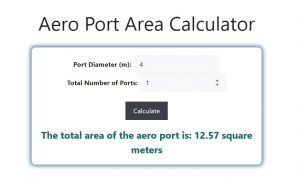About Aero Port Area Calculator (Formula)
In aerodynamics, understanding the port area is vital for optimizing airflow, enhancing performance, and ensuring safety in various applications such as engines, aircraft, and automotive systems. The Aero Port Area Calculator simplifies the process of calculating the cross-sectional area of a port, providing accurate measurements crucial for effective design and analysis. This calculator is particularly useful for engineers and designers who work in fields requiring precise airflow management.
Formula
The formula for calculating the port area (A) is:
A = π * D² / 4 * #
Where:
- A is the cross-sectional area of the port.
- D is the diameter of the port.
- π is a constant approximately equal to 3.14159.
- # is a constant or factor depending on the specific application, typically accounting for the number of ports or other design considerations.
How to Use
- Measure the Diameter: Determine the diameter (D) of the port in the appropriate units (usually inches or centimeters).
- Identify the Factor: Establish the value of the constant (#) based on your specific application (this could be 1 for a single port or adjusted for multiple ports).
- Input the Values: Enter the diameter and the factor into the Aero Port Area Calculator.
- Calculate the Area: The calculator will use the formula to compute the cross-sectional area of the port, providing you with the result.
Example
Suppose you have a port with a diameter of 4 inches and you are using it as a single port, so # = 1.
- D = 4 inches
- # = 1
Using the formula:
A = π * (4)² / 4 * 1
A = π * 16 / 4
A = π * 4
A ≈ 12.57 square inches
Therefore, the cross-sectional area of the port is approximately 12.57 square inches.

FAQs
- What is an aero port?
An aero port is an opening or duct designed to allow airflow in various systems, commonly found in engines, aircraft, and automotive applications. - Why is the port area important?
The port area influences airflow rates, performance, and efficiency in systems like engines and aerodynamic structures, making it crucial for design optimization. - What units can be used for diameter?
Diameter can be measured in various units, including inches, centimeters, or millimeters, depending on the specific application and region. - What does the constant (#) represent in the formula?
The constant represents a design factor that may vary based on the number of ports, specific application needs, or other considerations affecting airflow. - How do I measure the diameter accurately?
You can use calipers or a measuring tape to determine the diameter accurately, ensuring you measure at the widest part of the port. - Can this calculator be used for multiple ports?
Yes, you can use the calculator for multiple ports by adjusting the constant (#) accordingly to account for the total number of ports in your design. - What is the significance of π in the formula?
π is a mathematical constant essential for calculating the area of circular shapes, such as ports, and is approximately equal to 3.14159. - Is the Aero Port Area Calculator applicable in all engineering fields?
While primarily used in aerodynamics, it can also be applicable in other engineering fields where airflow management is important, such as HVAC and fluid dynamics. - How does the port area affect performance?
A properly calculated port area can enhance airflow, improve efficiency, and optimize performance in systems, leading to better overall function. - Can I use this calculator for non-circular ports?
This specific calculator is designed for circular ports; however, other calculations or formulas may be necessary for non-circular openings. - What happens if the port area is too small?
A port area that is too small can restrict airflow, leading to performance issues, increased pressure drop, and inefficiency in the system. - How often should I recalculate the port area?
You should recalculate the port area whenever there are changes in design specifications, such as modifications to diameter or the number of ports. - What factors influence the choice of port diameter?
Factors include the intended application, required airflow rates, system pressure, and design constraints. - Are there specific industry standards for port areas?
Yes, different industries may have specific standards and guidelines regarding port areas to ensure performance and safety. - Can the Aero Port Area Calculator assist in prototype design?
Yes, it can help designers quickly assess and optimize port sizes in prototype designs before final implementation. - How is airflow related to port area?
Generally, larger port areas allow for increased airflow, which can enhance system performance, whereas smaller areas can restrict flow. - What software tools are available for more complex calculations?
Various computational fluid dynamics (CFD) software tools can analyze airflow in more detail, including complex geometries and conditions. - Is there a recommended range for port diameters in specific applications?
Recommended ranges can vary widely based on the application, so consulting industry standards or design guidelines is advisable. - How do changes in temperature affect airflow through ports?
Changes in temperature can affect the density of air, which in turn can influence airflow rates and pressure within a system. - What should I do if I’m unsure about the diameter measurement?
If uncertain, double-check your measurement using multiple methods, or consult technical documentation for guidance on standard dimensions for your application.
Conclusion
The Aero Port Area Calculator is a valuable tool for engineers and designers seeking to optimize airflow in various applications. By using the formula A = π * D² / 4 * #, you can easily determine the cross-sectional area of a port, ensuring effective airflow management. Accurate calculations can lead to enhanced performance, efficiency, and safety in aerodynamics, automotive design, and other engineering disciplines.